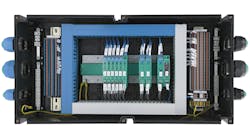Jeremy Pollard has been writing about technology and software issues for many years. He has been involved in control system programming and training for more than 25 years.
I visited my local McDonald’s to fill my very infrequent desire for a fish fillet sandwich, with fries, of course. It was an experience. Because I really don’t want to get my weight out where I can watch it shake, I ordered half tartar sauce on the sandwich. It felt good to give in a little. The gal who was serving me was pleasant, but you could tell that a simple request would get her flustered.
She had to have training right? I waited patiently while she tried to figure out how to enter the half order. I figured 2 minutes was long enough and suggested that it was ok to forgo the half sauce. I was rescued by a manager, and all was well. I wondered how long ago she had her training and what steps are taken to ensure that the training worked.
Also read: Is It Time to Suit Up With Personal Protective Equipment (PPE)?
So I ate the sandwich and went camping with Gus, my son-in-law engineering-type guy, who prides himself on self-learning. He has moved up the ranks in his current employment position due to his belief that you have to look after yourself with your continuing education. He just had some training on arc flash—energy flashover creating air ionization, explosions, and intense heat in electrical panels. Well, I thought, this is going to be an interesting conversation.
And it was. It ended with the instructor saying, “If someone can answer this question, then class is dismissed and you don’t have to do the end quiz.” So the question was asked, and Gus answered it correctly. The question was: "What dielectric withstand voltage are Class 0 gloves manufactured for?" The answer is 5,000 Vac.
What I found odd was the beginning of the course, where the instructor was ingraining the importance of knowing and implementing arc-flash protection while working in any electrical panel. The instructor was showing videos of the results of arc-flash events and included one where an unsuspecting electrician was working in a control panel and got blown back by an arc-flash explosion. The group was told the video was real and the person actually died.
This is Marketing 101—create a need. Well done, I would say, but something got lost in the translation as the course wore on. The class members were introduced to personal safety equipment required to properly protect themselves, including specifications for each class of protection, along with the types of panels that you need to be protected from when servicing.
Electricians can open and service 480 Vac panels in the United States and 600 Vac panels in Canada and work on them when under power. It is required as you cannot measure and troubleshot a low-voltage (<600 Vac) control panel with the power off. So the electricians open the door and start taking voltage measurements. Unfortunately, many times they don't use the proper tools or personal safety equipment.
The equipment that they would need to wear in order to properly protect themselves is daunting. Face shields, head scarves, jackets, pants, gloves, and, yes, insulated tools are all recommended at a minimum. So one wonders about the delays in troubleshooting and startups while the electrician suits up and then undresses to go into the field, wash and repeat.
Since the inconvenience of gearing up in the personal protection equipment (PPE) encourages not following the rules, why are they trained in the first place? They are trained to cover the liability. The company can say that all electrical and mechanical employees have had arc-flash training, so the company can no longer be held accountable if an accident happens.
So, now you have reasons to not follow the training and can claim ignorance as you were not required to take a test at the end of the training. Usually it is good to have some measurement of how well you learned the material. Since you have been trained in arc-flash safety, you, as an individual, are now responsible for your life when working in a control panel and don’t take the proper precautions.
Don't let taking too much time to fix an electrical issue be the fly in the ointment that gives you the green light to ignore the safety procedures. Once you have safety training, remember it and follow it as the ultimate responsibility lies in your own lap. Safety is everyone's responsibility including yours.
The McDonald’s issue resulted in a customer almost eating more calories than he wanted. An arc-flash issue can result in lost lives. Both had similar training from the outside looking in. Bad training in my mind, but hey the company paid for it and wipes their hands of responsibility. Remember Hill Street Blues? Let’s be careful out there.




